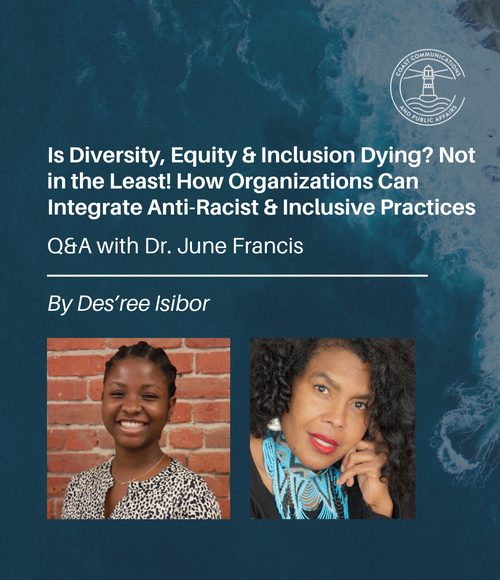AI is here. But what do we do about it as communications professionals?
If you are focused on the strategic side of the work or solving more complex public affairs-oriented issues for clients as we do at Coast Comms, it means we start learning it—fast.
But where do we apply it? Most articles and podcasts reviewing AI and PR are generic in their advice – last week, I even logged out of a webinar by a large wire service when the presenter admitted they don’t even use AI tools.
To help our Coast Insights readers, we have identified five specific ways you can start applying AI to your practice today. These are all tools Coast Comms team members use every day, not to save money or make more money, but to improve the quality of your work.
But before we talk tools, let’s talk guardrails. AI is only as good as our ability to ensure we reject poor quality analysis and understand good quality insight. This means the experience and knowledge of real people are still essential. AI can provide compelling but untrue answers, not unlike an enthusiastic intern. In fact, a Microsoft exec recently told a Greater Vancouver Board of Trade audience to treat it like an intern. AI can help make your work faster and help improve it, but you are ultimately accountable for the work—including asking for the right thing in the right way and checking the results.
5 specific ways PR pros can use AI
1. AI to kick off a writing project
- Hate the blank page? Who doesn’t. Sometimes deciding on the key topics and outlines is the hardest part of writing. Wordkraft can help with this – put in a topic and some keywords and get a decent outline to get you started. If you tend to lock into the same themes, this tool will freshen your thinking and expand the possible topics.
- Here’s an example where we are writing a piece on safety in the workplace:

- Right now, only the ChatGPT enterprise version (available but waitlisted) provides a protected sandbox to play in; this means if you upload a document for it to rewrite, that feeds into its learning module (not ideal for private or strategic documents).
- However, you can still ask theoretical questions about a scenario. It’s unlikely you’ll get an answer you can cut and paste into your plan, be it proactive or reactive, but it will give you another few ideas to consider
- Ask Chat about typical concerns about a project (e.g. large-scale clean energy) to start thinking through stakeholder issues. Here's some of the ideas it gave me:

3. AI to expand your reach and increase your knowledge of new markets
- Do you need to get a message out to a new market in which you have limited experience? The second-best option (the first being to hire a local consultant) is using tools to get fast insights into that market.
- One of the best things about the current suite of AI tools is that they can analyze vast amounts of data to understand and summarize a decision, issue, company or even audience group much better than a site like Wikipedia.
- Try a version of this prompt and see what you get. Remember to tell the AI who it “is” and the scope of the work to be done. Also, keep in mind that internet inputs to Chat GPT-4 stopped in September 2021, so there may be some additional research needed to update the analysis.
- In the guise of a communications and public relations professional, and using the demographics about both BC and Saskatchewan, provide a 1,000-word overview of some different ways Saskatchewan views the environment compared to British Columbians. Including any polling done in 2021. Cite specific polls, media releases and studies that describe attitudes of Saskatchewanians.
4. AI to provide insights into your audiences:
- PR professionals are often asked to make game-time decisions on how an audience might respond to a message, be it in a crisis, a strategy presentation to the C Suite or last-minute changes to a business decision you are rolling out.
- You can ask Chat GPT-4 to give you insights into considerations when communicating with that audience.
- E.g. Prompt (based on the recent closure of Highway 3 in the Okanagan): In the guise of a corporate communications consultant, propose 3 ways that an announcement about a closure of a major highway may impact a small, rural community. That community has a large number of seniors as well as is a tourism center. The median income is $55,000 Canadian per year.
Here is the response:

- The social isolation for seniors was a good point. If I were advising area governments, I might highlight social programs to remind them of the supports in the community and signal to seniors that we were considering their needs.
- I also hadn’t thought about the property ownership. However, by seeing it in the results, I realized that I hadn’t specified that the shutdown would be temporary — a reminder that garbage in is garbage out!
5. AI to customize graphics and imagery
Canva, the graphics cheat we all love (except for graphics professionals) was an early adopter of text-to-image AI. Need a very specific visual for your strategic comms plan deck? Canva can deliver it in whatever style you want — and iterate to get closer and closer to what you want.
Here are two examples, with the prompt in the Magic Media app in Canva: logging truck going through a large thriving Canadian city.


In summary, your yearly subscription budget for AI-based software will be increasing, but the payoff to you and your internal or external clients will be well worth it. And more importantly, if you don’t start using these tools, you’ll be left behind.
Note: This article was written by a real human, but we did use Wordkraft to look for other topics to include after it was written.



